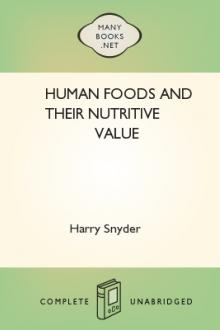Human Foods and Their Nutritive Value by Harry Snyder (dark academia books to read .TXT) 📕

- Author: Harry Snyder
- Performer: -
Book online «Human Foods and Their Nutritive Value by Harry Snyder (dark academia books to read .TXT) 📕». Author Harry Snyder
CHAPTER XXI
LABORATORY PRACTICE 299
Object of Laboratory Practice; Laboratory Note-book and Suggestions for Laboratory Practice; List of Apparatus Used; Photograph of Apparatus Used; Directions for Weighing; Directions for Measuring; Use of Microscope; Water in Flour; Water in Butter; Ash in Flour; Nitric Acid Test for Nitrogenous Organic Matter; Acidity of Lemons; Influence of Heat on Potato Starch Grains; Influence of Yeast on Starch Grains; Mechanical Composition of Potatoes; Pectose from Apples; Lemon Extract; Vanilla Extract; Testing Olive Oil for Cotton Seed Oil; Testing for Coal Tar Dyes; Determining the Per Cent of Skin in Beans; Extraction of Fat from Peanuts; Microscopic Examination of Milk; Formaldehyde in Cream or Milk; Gelatine in Cream or Milk; Testing for Oleomargarine; Testing for Watering or Skimming of Milk; Boric Acid in Meat; Microscopic Examination of Cereal Starch Grains; Identification





Comments (0)